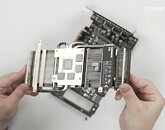TheLostSwede
News Editor
- Joined
- Nov 11, 2004
- Messages
- 18,928 (2.51/day)
- Location
- Sweden
| System Name | Overlord Mk MLI |
|---|---|
| Processor | AMD Ryzen 7 7800X3D |
| Motherboard | Gigabyte X670E Aorus Master |
| Cooling | Noctua NH-D15 SE with offsets |
| Memory | 32GB Team T-Create Expert DDR5 6000 MHz @ CL30-34-34-68 |
| Video Card(s) | Gainward GeForce RTX 4080 Phantom GS |
| Storage | 1TB Solidigm P44 Pro, 2 TB Corsair MP600 Pro, 2TB Kingston KC3000 |
| Display(s) | Acer XV272K LVbmiipruzx 4K@160Hz |
| Case | Fractal Design Torrent Compact |
| Audio Device(s) | Corsair Virtuoso SE |
| Power Supply | be quiet! Pure Power 12 M 850 W |
| Mouse | Logitech G502 Lightspeed |
| Keyboard | Corsair K70 Max |
| Software | Windows 10 Pro |
| Benchmark Scores | https://valid.x86.fr/yfsd9w |
ASUS Chinese GM—Tony Yu—has shown off a graphics card concept on Bilibili that has a rather unusual feature, a slot for an M.2 NVMe SSD. The card is based on NVIDIA's GeForce RT 4060 Ti GPU and although not all details are clear at this point in time, but ASUS is taking advantage of the unused PCIe lanes on the card, since the AD106 GPU only uses eight PCIe lanes, the PCIe connector on the card has space for a further eight lanes. In theory ASUS could have added a pair of SSDs, since there are a total of eight lanes available, but as this was just a proof of concept, they seemingly stuck with a single SSD.
It's unclear if ASUS relies on bifurcation or if the company has added some kind of bridge chip, but bifurcation makes more sense, as a bridge chip would add a lot more cost. The neat thing with the NVMe drive being on the GPU, is that it also connects to the heatsink of the graphics card, which means the cooling should be rather good. However, for this to work properly, the SSD would have to be mounted back to front compared to how it would be mounted on a motherboard. Based on the test results, the SSD runs at a cool 42 degrees C, even when the GPU is being stress tested. It's likely that this product will not make it to markets outside of China, if it's ever launched into retail.




View at TechPowerUp Main Site | Source
It's unclear if ASUS relies on bifurcation or if the company has added some kind of bridge chip, but bifurcation makes more sense, as a bridge chip would add a lot more cost. The neat thing with the NVMe drive being on the GPU, is that it also connects to the heatsink of the graphics card, which means the cooling should be rather good. However, for this to work properly, the SSD would have to be mounted back to front compared to how it would be mounted on a motherboard. Based on the test results, the SSD runs at a cool 42 degrees C, even when the GPU is being stress tested. It's likely that this product will not make it to markets outside of China, if it's ever launched into retail.




View at TechPowerUp Main Site | Source





